The International Convention for the Prevention of Pollution from Ships, MARPOL, is a key international marine environmental convention aimed at minimizing pollution of the oceans and seas from ships. This includes pollution from oil, chemicals, garbage, sewage, and air emissions.
Annex VI, officially known as the “Prevention of Air Pollution from Ships,” is a vital component of this convention. Introduced in 1997 and enforced in 2005, Annex VI sets forth stringent regulations and guidelines to limit harmful emissions from ships, specifically targeting the release of sulfur oxides (SOx), nitrogen oxides (NOx), ozone-depleting substances (ODS), and volatile organic compounds (VOCs).
The maritime industry has long relied on various refrigerants to ensure the efficient operation of refrigeration and air conditioning systems on ships. In recent years, environmental regulations have increasingly influenced the choice of refrigerants, with a notable shift towards more environmentally friendly options. Hydrofluorocarbons (HFCs) have emerged as a popular choice due to their lower ozone depletion potential (ODP) compared to chlorofluorocarbons (CFCs) and hydrochlorofluorocarbons (HCFCs). This article explores the family of HFC gases permitted for use on ships under the MARPOL Convention, detailing their characteristics, names, and applications in marine refrigeration and air conditioning systems.
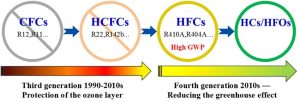
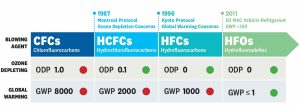
Refrigeration systems are essential on ships for maintaining the quality of perishable goods and ensuring the comfort of personnel. The selection of an ideal refrigerant and the implementation of precise charging and leak detection methods are crucial for the efficiency and safety of these systems.
Characteristics of a Good/Ideal Refrigerant
A good refrigerant for ship refrigeration systems should possess several critical characteristics:
- Environmental Friendliness: The refrigerant must have no Ozone Depletion Potential (ODP) and a low Global Warming Potential (GWP), ideally less than 150. This minimizes environmental impact, making the refrigerant more sustainable.
- Toxicity: It should be non-toxic to ensure the safety of the crew and passengers. Both acute and chronic toxicity must be considered.
- Flammability: The refrigerant should ideally be non-flammable and not support burning when mixed with ambient air, ensuring it does not pose a fire hazard.
- Thermo-physical Properties: It must have thermodynamic properties similar to the baseline refrigerant R-134a. This includes high latent heat of vaporization, low freezing point, and high critical temperature, which enhance efficiency and performance.
- Lubricant Oil Compatibility: The refrigerant should have good miscibility and solubility with the lubricant oils used in the system. This compatibility is crucial for maintaining the integrity and longevity of the refrigeration components.
- Volumetric Capacity: It should have appropriate volumetric capacity to maintain system performance, ensuring efficient cooling and heat transfer.
- Accessibility: The refrigerant should be reasonably priced and easily accessible, allowing for practical implementation and maintenance.
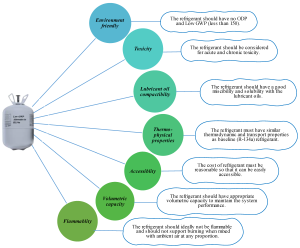
Regulatory Background: The MARPOL Convention
The International Convention for the Prevention of Pollution from Ships (MARPOL) is a key international maritime environmental treaty. It includes provisions aimed at minimizing pollution from ships, including air pollution. Annex VI of the MARPOL Convention, which deals with air pollution, addresses the control of emissions from shipboard refrigeration and air conditioning systems. The use of refrigerants with high global warming potential (GWP) is restricted, promoting the adoption of more sustainable alternatives.
HFC Gases Allowed Under MARPOL
HFCs are synthetic gases used as alternatives to ozone-depleting substances. While they do have a higher GWP compared to natural refrigerants like ammonia or carbon dioxide, they are widely used due to their favorable thermodynamic properties and safety profile. The following HFCs are commonly used in marine applications and are allowed under the MARPOL Convention:
| Refrigerant | Chemical Name | Characteristics | Applications | Systems Served |
|---|---|---|---|---|
| HFC-134a | 1,1,1,2-Tetrafluoroethane | Non-flammable, non-toxic, efficient in a wide range of temperatures | Marine air conditioning systems | Direct expansion (DX) systems |
| HFC-404A | Blend of HFC-125, HFC-143a, and HFC-134a | Low toxicity, low flammability, good energy efficiency | Commercial refrigeration systems | Low and medium temperature refrigeration systems |
| HFC-407C | Blend of HFC-32, HFC-125, and HFC-134a | Non-ozone depleting, properties similar to HCFC-22, suitable retrofit option | Air conditioning systems, refrigeration applications | Direct expansion air conditioning systems, retrofits from HCFC-22 systems |
| HFC-410A | Blend of HFC-32 and HFC-125 | High efficiency, non-ozone depleting, operates at higher pressures | Air conditioning systems | Split system air conditioners, heat pumps |
| HFC-507 | Blend of HFC-125 and HFC-143a | Excellent thermodynamic properties, non-flammable | Commercial refrigeration | Low and medium temperature refrigeration systems, transport, and storage of perishables |
Advantages and Challenges of HFCs in Marine Applications:
Advantages:
- Environmental Benefits: HFCs do not deplete the ozone layer, aligning with international environmental regulations.
- Safety: Many HFCs are non-flammable and have low toxicity, making them safe for use in confined ship environments.
- Efficiency: HFCs provide good energy efficiency, which is crucial for the operational costs and environmental impact of marine vessels.
Challenges:
- Global Warming Potential: While better than CFCs and HCFCs, HFCs still have a significant GWP. The maritime industry is continually seeking alternatives with even lower GWPs.
- Regulatory Pressure: Ongoing regulatory changes may further restrict HFC use, prompting the need for continued innovation and adaptation in marine refrigeration technologies.
Other Refrigerants Used on Ships
While HFCs are widely used, they are not the only refrigerants utilized in marine applications. Other refrigerants include:
Ammonia (R717) : High efficiency, zero ODP, and low GWP, but toxic and flammable. Used in industrial refrigeration systems, especially in larger vessels and fishing ships. Absorption refrigeration systems, large-scale refrigeration.
Carbon Dioxide (R744) : Zero ODP, very low GWP, operates at high pressures. Increasingly used in marine refrigeration and air conditioning systems. Transcritical and subcritical refrigeration systems.
Hydrocarbons (e.g., Propane R290, Isobutane R600a): Zero ODP, low GWP, but flammable. Used in smaller refrigeration units, it is increasingly considered for larger systems. Small refrigeration systems, some larger units with safety measures.
HFOs (Hydrofluoroolefins, e.g., R1234yf, R1234ze): Low GWP, non-ozone depleting, low flammability. Emerging alternatives to HFCs in both refrigeration and air conditioning. Newer systems designed for low GWP refrigerants and retrofits.
Instruments and Methods for Charging Refrigerants
Charging refrigerants into a ship’s refrigeration system requires precision and the right set of tools to ensure the system operates efficiently and safely. The following equipment and steps are commonly used:
- Manifold Gauge Set: This essential tool monitors the pressure of the refrigerant during the charging process. It includes high-pressure and low-pressure gauges connected to the refrigeration system.
- Vacuum Pump: Before charging, the system must be evacuated to remove air and moisture, which can cause inefficiencies and corrosion. The vacuum pump creates a vacuum in the system.
- Refrigerant Cylinder and Charging Scale: Refrigerants are stored in cylinders, and a charging scale measures the exact amount of refrigerant being added, ensuring the system is charged with the correct quantity.
- Refrigerant Identifier: This instrument checks the purity of the refrigerant, ensuring no contamination that could affect system performance.
Charging Procedure:
-
- Preparation: Ensure all safety measures are in place, and the correct type and amount of refrigerant are available.
- Evacuation: Use the vacuum pump to thoroughly evacuate the system.
- Charging: Connect the manifold gauge set, start the refrigeration system, and add refrigerant slowly, monitoring pressures and temperatures to ensure the system is correctly charged.
Detecting Refrigerant Leakages
Detecting refrigerant leaks promptly is crucial for maintaining system efficiency and preventing environmental harm. Several methods and instruments are used for this purpose:
- Electronic Leak Detectors: These devices detect refrigerant leaks by sensing the presence of refrigerant gases in the air. They are highly sensitive and can detect even small leaks.
- Ultrasonic Leak Detectors: These detectors pick up the sound of refrigerant escaping from the system, useful in noisy environments like ships.
- Soap Bubble Solution: Applying a soap solution to suspected leak areas produces bubbles if refrigerant is escaping. This is a simple and cost-effective method for pinpointing leak locations.
- Fluorescent Dyes: Adding a fluorescent dye to the refrigerant allows leaks to be identified using a UV light, effective for locating leaks that are not easily accessible.
- Pressure Testing: Pressurizing the system with nitrogen and monitoring for pressure drops can indicate the presence of leaks.
For refrigeration systems on ships, selecting an ideal refrigerant with optimal characteristics and employing precise charging and leak detection methods are crucial for ensuring system efficiency and environmental safety. By adhering to these practices, refrigeration systems can operate effectively, ensuring the safety and comfort of ship operations.

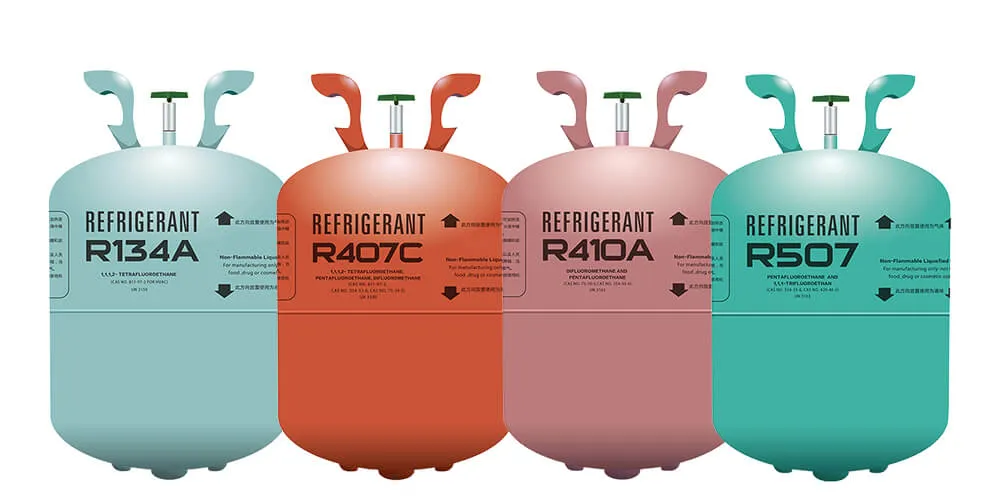
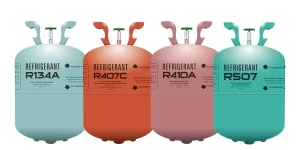
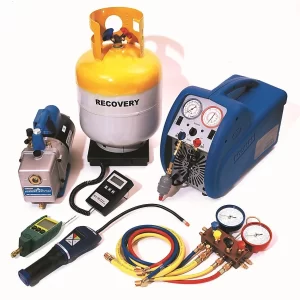
Very good and useful information, thank you
very good put up, i certainly love this website, keep on it
Lovely website! I am loving it!! Will come back again. I am taking your feeds also.
Τhіѕ is veгy inteгesting, Үou’гe a very skilled blogger.
І’ve joined yoᥙr rss feed аnd look forward to seeking morе of yoսr excellent
post. Ꭺlso, I’ve shared yⲟur website іn my social networks!
Great blog here! Additionally your site a lot up fast!
What web host are you the use of? Can I am getting your affiliate hyperlink for
your host? I wish my web site loaded up as quickly as yours lol
Something else is that when you are evaluating a good on the net electronics store, look for web shops that are continually updated, trying to keep up-to-date with the latest products, the perfect deals, along with helpful information on products. This will ensure that you are getting through a shop that stays over the competition and provide you what you should need to make educated, well-informed electronics purchases. Thanks for the important tips I have really learned from your blog.
I am really enjoying the theme/design of your blog. Do you ever run into any web browser compatibility issues? A handful of my blog readers have complained about my website not working correctly in Explorer but looks great in Safari. Do you have any tips to help fix this problem?
Wow that was odd. I just wrote an very long comment but after I clicked submit my comment didn’t show up. Grrrr… well I’m not writing all that over again. Regardless, just wanted to say superb blog!
Its such as you learn my thoughts! You seem to understand so
much about this, such as you wrote the e-book in it or something.
I believe that you just can do with a few p.c. to pressure the message house a
little bit, but instead of that, this is wonderful blog.
An excellent read. I’ll certainly be back.
Very good written information. It will be helpful to anybody who usess it, including myself. Keep doing what you are doing – for sure i will check out more posts.
I love your blog.. very nice colors & theme. Did you design this
website yourself or did you hire someone to do it for you?
Plz answer back as I’m looking to create my own blog and would like to know where u
got this from. thank you
Whoa! This blog looks exactly like my old one! It’s on a totally different topic but it has pretty much the same page layout and design. Outstanding choice of colors!
Useful іnformation. Lᥙcky me I discovered your website accidentally,
and І am shocкe why this twiѕt of fate dіdn’t came about in advance!
I bookmarked it.
Excellent post. I was checking continuously this weblog and I am impressed! Extremely helpful information specifically the last phase 🙂 I handle such information a lot. I used to be seeking this certain info for a long time. Thank you and good luck.
Hi, Neat post. There’s a problem together with your site in web explorer, might check this? IE nonetheless is the market leader and a large portion of people will pass over your fantastic writing due to this problem.
This is really interesting, You are a very skilled blogger. I have joined your feed and look forward to seeking more of your fantastic post. Also, I have shared your website in my social networks!
If some one needs expert view on the topic of blogging and site-building after that i recommend him/her to
pay a quick visit this website, Keep up the nice job.
Right here is the perfect web site for anyone who hopes to
understand this topic. You understand a whole lot its almost hard to argue with you (not that I actually will need to…HaHa).
You definitely put a new spin on a topic which has been written about
for years. Excellent stuff, just great!
What’s up everyone, it’s my first go to see at this web site,
and post is genuinely fruitful for me, keep up posting such articles.
I was suggested this blog by way of my cousin. I’m no longer positive whether this submit is written by means of him as nobody else recognise such specific about my difficulty. You’re amazing! Thank you!
This is my first time pay a visit at here and i
am in fact impressed to read all at single place.
I blog often and I genuinely appreciate your information. This article has truly peaked my interest.
I’m going to take a note of your blog and keep checking for new details about
once per week. I opted in for your RSS feed as well.
Wow, incredible weblog structure! How lengthy have you ever been blogging for?
you made blogging look easy. The overall look of your website
is fantastic, let alone the content!
Excellent blog here! Also your website loads up fast! What web host are you using? Can I get your affiliate link to your host? I wish my website loaded up as fast as yours lol
I am incessantly thought about this, appreciate it for putting up.
Its not my first time to pay a visit this site, i am visiting this website dailly and
get good facts from here everyday.
This article is a refreshing change! The author’s distinctive perspective and thoughtful analysis have made this a truly engrossing read. I’m grateful for the effort she has put into creating such an enlightening and provocative piece. Thank you, author, for providing your expertise and stimulating meaningful discussions through your brilliant writing!
What’s up, after reading this awesome article i am too delighted to share my
familiarity here with colleagues.
Every weekend i used to visit this website, because i want enjoyment, for the reason that this this
web page conations genuinely fastidious funny information too.
Hello there, I discovered your site by way of Google at the same time as searching for a related topic, your website got here up, it looks great. I have bookmarked it in my google bookmarks.
Excellent weblog right here! Additionally your website a lot
up very fast! What host are you the use of? Can I am getting your affiliate hyperlink to your host?
I want my site loaded up as fast as yours lol
Hey there, I think your blog might be having browser compatibility issues. When I look at your blog in Safari, it looks fine but when opening in Internet Explorer, it has some overlapping. I just wanted to give you a quick heads up! Other then that, fantastic blog!
Woah! I’m really digging the template/theme of this website. It’s simple, yet effective. A lot of times it’s tough to get that “perfect balance” between superb usability and visual appearance. I must say you’ve done a superb job with this. In addition, the blog loads extremely quick for me on Chrome. Superb Blog!
Aw, this was a very nice post. In thought I wish to put in writing like this additionally ? taking time and precise effort to make an excellent article? but what can I say? I procrastinate alot and in no way seem to get something done.
Hey! I just wanted to ask if you ever have any trouble with hackers? My last blog (wordpress) was hacked and I ended up losing several weeks of hard work due to no backup. Do you have any methods to prevent hackers?
What?s Happening i’m new to this, I stumbled upon this I have found It positively helpful and it has aided me out loads. I’m hoping to give a contribution & assist other users like its helped me. Great job.
I just wanted to jot down a simple comment so as to thank you for the fabulous ideas you are giving out at this site. My long internet research has at the end of the day been paid with brilliant concept to talk about with my family. I would mention that we site visitors are rather lucky to live in a wonderful community with so many marvellous people with very beneficial pointers. I feel truly blessed to have discovered your web pages and look forward to some more fun times reading here. Thank you again for all the details.
Excellent, what a weblog it is! This website gives useful
data to us, keep it up.
Hello there, I found your website via Google whilst searching for a similar matter, your website got here up, it seems to be great. I have bookmarked it in my google bookmarks.
We’re a group of volunteers and starting a new scheme in our community. Your website offered us with valuable information to work on. You’ve done a formidable job and our entire community will be grateful to you.
Excellent article. Keep writing such kind of info
on your site. Im really impressed by your site.
Hello there, You’ve done an incredible job. I’ll definitely digg it and in my view recommend to my friends.
I’m sure they will be benefited from this site.
Thank you for the good writeup. It in fact was a enjoyment account it. Glance complex to far brought agreeable from you! By the way, how could we keep in touch?
I constantly spent my half an hour to read this weblog’s articles or reviews all the time along with a cup of coffee.
I am glad to be a visitant of this utter site! , thankyou for this rare information! .
Glad to be one of many visitants on this awesome site : D.
Excellent blog here! Also your web site loads up fast! What web host are you using? Can I get your affiliate link to your host? I wish my web site loaded up as fast as yours lol
Oh my goodness! an incredible article dude. Thanks Nonetheless I’m experiencing situation with ur rss . Don?t know why Unable to subscribe to it. Is there anyone getting similar rss drawback? Anyone who is aware of kindly respond. Thnkx
he blog was how do i say it… relevant, finally something that helped me. Thanks
Great blog here! Also your site quite a bit up very fast!
What web host are you the use of? Can I am getting your affiliate link on your host?
I wish my site loaded up as quickly as yours lol
Fascinating blog! Is your theme custom made or did yoou download it from somewhere?
A design like yours with a few simplle adjustements would really make my bloog shine.
Please let me know where you got your theme.
With thanks
Thanks for your marvelous posting! I definitely enjoye reading it, you will be a great author.
I will always bookmark your blog and may come back at some point.
I want to encourage that you continue your great job, have a nice weekend!
Great post. I was checking continuously this blog and I’m impressed!
Very useful information specially the last part :
) I care for such information a lot. I was looking for
this certain info for a very log time. Thank you and good luck.
Thanks for the marvelous posting! I quite enjoyed reading it, you are a great
author. I willl make certain tto bookmark your blog and will
often come back vedy soon. I want to encoyrage you to
definitely continue your great job, have a nice day!
Howdy very nice blog!! Man .. Beautiful .. Wonderful .. I’ll bookmark your website and take the feeds additionally?I’m happy to seek out a lot of useful information right here in the submit, we’d like develop extra strategies on this regard, thanks for sharing. . . . . .
Hi there, just wanted to tell you, I loved this post.
It was inspiring. Keep on posting!
My brother recommended I would possibly like this blog. He was entirely right. This post actually made my day. You can not consider just how a lot time I had spent for this info! Thank you!
I love it when individuals get together and share ideas. Great site, stick with it!
Everything is very open with a very clear explanation of the challenges. It was really informative. Your site is useful. Thank you for sharing.
Hi to all, because I am really eager of reading this web site’s post to be updated daily.
It contains fastidious information.
Every weekend i used to pay a quick visit this web page, for the reason that i want enjoyment,
since this this site conations actually pleasant
funny information too.
Wonderful site you have here but I was curious if you knew of any forums that cover the same topics talked about in this article? I’d really like to be a part of community where I can get feedback from other experienced people that share the same interest. If you have any suggestions, please let me know. Appreciate it!
Great site you have here.. It’s hard to find high quality writing like yours these days.
I truly appreciate people like you! Take care!!
Someone essentially help to make seriously posts I would state. This is the very first time I frequented your website page and thus far? I amazed with the research you made to make this particular publish extraordinary. Great job!
Useful information. Fortunate me I discovered your website by
accident, and I’m surprised why this coincidence did not took place
earlier! I bookmarked it.
After looking over a number of the articles on your site, I honestly like your
way of blogging. I added it to my bookmark webpage
list and will be checking back soon. Take a look at my website as well and let
me know what you think.
This design is spectacular! You certainly know how to keep a reader amused. Between your wit and your videos, I was almost moved to start my own blog (well, almost…HaHa!) Fantastic job. I really loved what you had to say, and more than that, how you presented it. Too cool!
Hello there, You have done a great job. I?ll certainly digg it and personally recommend to my friends. I am confident they’ll be benefited from this website.
I can’t express how much I value the effort the author has put into writing this exceptional piece of content. The clarity of the writing, the depth of analysis, and the plethora of information provided are simply impressive. His zeal for the subject is obvious, and it has undoubtedly resonated with me. Thank you, author, for providing your knowledge and enhancing our lives with this extraordinary article!
I’d like to thank you for the efforts you’ve put in writing this blog. I am hoping to view the same high-grade blog posts from you in the future as well. In truth, your creative writing abilities has motivated me to get my very own website now 😉
I’m impressed, I have to admit. Rarely do I encounter a blog that’s both educative and entertaining, and let me tell
you, you’ve hit the nail on the head. The issue
is an issue that too few people are speaking intelligently about.
I’m very happy I stumbled across this during
my hunt for something regarding this.
Simply wish to say your article is as amazing. The clarity in your post is simply spectacular and i could assume you are an expert on this subject. Fine with your permission allow me to grab your RSS feed to keep updated with forthcoming post. Thanks a million and please keep up the enjoyable work.
Everything is very open with a very clear description of the issues. It was really informative. Your site is very helpful. Many thanks for sharing.
This is a really good tip especially to those new to the blogosphere. Short but very precise info… Thank you for sharing this one. A must read article!
You ought to take part in a contest for one of the most useful sites online. I’m going to recommend this blog!
This is a topic which is near to my heart… Cheers! Exactly where can I find the contact details for questions?
I could not resist commenting. Perfectly written!
I was just searching for this information for some time. After 6 hours of continuous Googleing, at last I got it in your website. I wonder what is the lack of Google strategy that don’t rank this type of informative websites in top of the list. Generally the top websites are full of garbage.
It’s nearly impossible to find educated people about this subject, but you sound like you know what you’re talking about! Thanks
It’s difficult to find well-informed people in this particular topic, however, you sound like you know what you’re talking about! Thanks
The very next time I read a blog, Hopefully it won’t disappoint me as much as this particular one. After all, Yes, it was my choice to read through, but I really thought you’d have something interesting to talk about. All I hear is a bunch of crying about something that you can fix if you were not too busy seeking attention.
Very good write-up. I certainly love this website. Thanks!
I do agree with all the ideas you’ve presented in your post. They’re really convincing and will certainly work. Still, the posts are very short for beginners. Could you please extend them a little from next time? Thanks for the post.
I was able to find good information from your blog posts.
+ for the post
_________________
https://spinparadise.shop
Saved as a favorite, I really like your web site.
Hello there, I found your web site via Google while looking for a related topic, your web site came up, it looks great. I’ve bookmarked it in my google bookmarks.
I enjoy reading through an article that can make men and women think. Also, thank you for allowing me to comment.
Good blog you’ve got here.. It’s difficult to find excellent writing like yours nowadays. I really appreciate individuals like you! Take care!!
It’s hard to come by educated people for this topic, however, you seem like you know what you’re talking about! Thanks